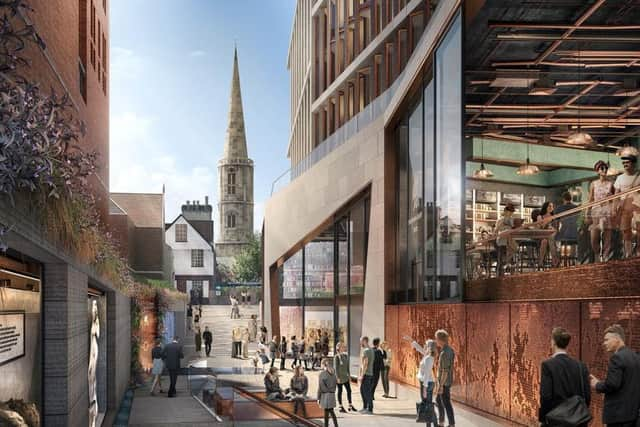Here's how a major new archaeological attraction aims to aid York’s recovery
York Archaeological Trust is planning to operate the Rougier Street archaeological dig, over two years, as a major new draw for visitors, if planning permission is approved later this year for a new landmark building.
The new premises will be known as The Roman Quarter and it has been described as “the perfect addition” to York’s tourism offering.
Advertisement
Hide AdAdvertisement
Hide AdThe proposals, which include the creation of a new Roman-themed visitor attraction operated by the Trust which already runs leading attractions including Jorvik Viking Centre in York, are set to be considered by York Council in the autumn.


But in the post-Covid world, the short-term plans could be just as helpful to the wider city as the long term vision, according to Sarah Maltby, director of attractions for York Archaeological Trust.
She said: “We have no idea what the next 12 months will bring for tourism in York – whether that is a gradual relaxing of social distancing rules and increased capacity for indoor spaces, or a tightening of restrictions if there are signs of a second wave of infection – but we do know that some of York’s indoor attractions are struggling to operate with low capacities and social distancing rules, including our two attractions within the city bars.
“An outdoor city centre attraction focused on heritage and history would be a perfect addition to York’s visitor economy, and that’s what we’re looking to provide with public access to the dig site over the two years that we are excavating.”
Advertisement
Hide AdAdvertisement
Hide AdUnder the Trust’s plans, a canopy will cover the site to enable digging to continue in all weathers over the two years, which will make it accessible to visitors as well as local people.
Ms Maltby added: “A big part of the Trust’s remit is to support education, so we’ve made a target of every school child in York visiting the site during the dig.
“Just as children peered through the hoardings of the Coppergate when they visited the city centre with their parents in the late 1970s, we want today’s children to engage with this exploration of York’s history with physical visits and online activities that they will tell their own children about.”
Over the course of the two-year excavation, archaeologists expect to find traces of many different eras in York’s history, from Victorians to Vikings, Anglo-Saxons to Roman settlers, as evidence unearthed at neighbouring sites suggests that the area sits adjacent to the main bridge into the military base that gradually expanded to become the Roman city of Eboracum.
Advertisement
Hide AdAdvertisement
Hide AdIan Milsted, lead archaeologist for the project, said: “This is a site incredibly rich with archaeology, so we are very excited about what we may unearth – potentially, this could give us the same kind of insights into life in Roman York as the Coppergate dig gave us into Viking life.”
David Jennings, chief executive of York Archaeological Trust, added: “We want local people to feel a sense of ownership, not just now, but for years to come as
this historic site becomes as important to the city’s Roman heritage as Coppergate does for the Vikings.”
‘World-leader’ in historical interpretation
York Archaeological Trust has long been considered a world-leader in archaeological interpretation, with the Jorvik Viking Centre having welcomed over 19 million visitors since it opened in 1984.
Advertisement
Hide AdAdvertisement
Hide AdThe attraction was built on the site where archaeologists uncovered remarkably well-preserved Viking remains – including organic material, from wood and leather to human excrement – which has given historians a unique insight into life in 10th century York. The Rougier Street site is known to have similar soil conditions which preserved the 1,000-year-old timbers down to Roman levels – potentially providing similar preservation of 2,000-year-old Roman remains.
The new proposals for the Roman Quarter, submitted last month, reduced the height and mass of the building and it is now proposed to be lower than the three buildings around it, to ensure it fits in with its surroundings.
David Jennings, chief executive of York Archaeological Trust, said: “Creating something that will have a real impact on the city... has been at the heart of this scheme from the outset.”
____________________________
Support The Yorkshire Post and become a subscriber today.Your subscription will help us to continue to bring quality news to the people of Yorkshire. In return, you'll see fewer ads on site, get free access to our app and receive exclusive members-only offers.
Advertisement
Hide AdAdvertisement
Hide AdSo, please - if you can - pay for our work. Just £5 per month is the starting point. If you think that which we are trying to achieve is worth more, you can pay us what you think we are worth. By doing so, you will be investing in something that is becoming increasingly rare. Independent journalism that cares less about right and left and more about right and wrong. Journalism you can trust.
Thank you
James Mitchinson
Comment Guidelines
National World encourages reader discussion on our stories. User feedback, insights and back-and-forth exchanges add a rich layer of context to reporting. Please review our Community Guidelines before commenting.